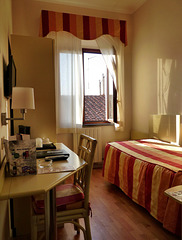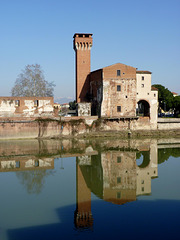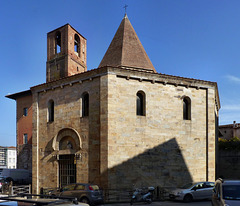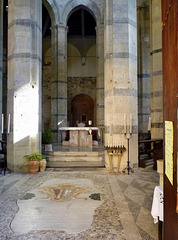
Tuscany / Toscana
Old and new photos from various voyages..
Pienza - Pieve di Corsignano
| |
|
|
The small 12th century church was built from tuff. Silvius Piccolomini was baptized in this church, who being Pope Pio II later, renamed and remodeled Pienza - but fortunately did not touch the Pieve di Corsignano. Here is the lintel of the main entrance, seeming very mythological and fantastic to me. A twotailed siren in the middle, another onetailed left, holding a kind of violin, a "beast" whispers into her ear. Maybe even licks the ear. Two ladies dancing (?) on the right side - and another beasts, whispering or licking.On boths sides under the lintel (not on the photo) are two very weathered and partly destroyed exhibitionistic figures. Male left - femal right.
Pienza - Pieve di Corsignano
Pienza - Pieve di Corsignano
| |
|
..there was a very narrow stair leading down into the dark. A strange smell. Reached the end of the stair. Now it was pitchdark. There was an iron grill. I walked on very cautiosly and found out, that there was a big pillar. The only way, to see that, was to use the flashlight. So I saw, that in the middle of the low dark crypt of the small church is a massive pillar with an archaic capital, compared to the carvings "upstairs". Maybe the crypt is older..
Pienza - Pieve di Corsignano
| |
|
|
The magi riding on horsebacks, approaching Bethlehem. The two first show the direction with their hand. The annunciation to the shepherds. Another angle guards the swaddled Jesus in the crib. Ox and ass watch him as well.
Pisa - Hotel Bologna
Pisa - Santa Maria della Spina
| |
|
|
|
On the right bank of the Arno is the small Gothic church "Santa Maria della Spina", built in 1230. At that time it was known as "Santa Maria di Pontenovo" - I am standing on that "new bridge". In 1333 the name of the church was changed, as since then a relic believed to be a thorn ("spina") of the Crown of Thorns was venerated here.
The church originally was erected right on the banks of the river, but in 1871 it was dismantled and rebuilt on the higher level.
Pisa - San Paolo a Ripa d'Arno
| |
|
|
A church existed, near the banks of the river Arno = "Ripa d'Arno", since Carolingian times. When this fell into ruins, the erection of the church seen today, startet in the 10th century. It took more than two centuries, to complete "San Paolo a Ripa d'Arno", that got consecrated already by Pope Eugene III already in 1148. The church belonged to a various convents over centuries, but since 1798 the church serves the parish.
Mid 19th century the church underwent a major reconstruction - and suffered great damage during WWII. It got restorated in the early 1950s, but as seen here, needs efforts again - and so it was cordoned off in March 2013.
Pisa - San Paolo a Ripa d'Arno
| |
|
|
A church existed, near the banks of the river Arno = "Ripa d'Arno", since Carolingian times. When this fell into ruins, the erection of the church seen today, startet in the 10th century. It took more than two centuries, to complete "San Paolo a Ripa d'Arno", that got consecrated already by Pope Eugene III already in 1148. The church belonged to a various convents over the centuries, but since 1798 the church serves the parish.
The church is a three-aisled basilica on the floor plan of a Latin cross. The crossing has a pendentive cupola.
Mid 19th century the church underwent a major reconstruction - and suffered great damage during WWII. It got restorated in the early 1950s, but as seen here, needs efforts again - and so it was cordoned off in March 2013.
Pisa - San Paolo a Ripa d'Arno
| |
|
|
|
A church existed, near the banks of the river Arno = "Ripa d'Arno", since Carolingian times. When this fell into ruins, the erection of the church seen today, startet in the 10th century. It took more than two centuries, to complete "San Paolo a Ripa d'Arno", that got consecrated already by Pope Eugene III already in 1148. The church belonged to a various convents over the centuries, but since 1798 the church serves the parish.
The church is a three-aisled basilica on the floor plan of a Latin cross with wonderful details on the western facade.
Mid 19th century the church underwent a major reconstruction - and suffered great damage during WWII. It got restorated in the early 1950s.
Pisa - Cappella di Sant'Agata
| |
|
|
|
Just behind San Paolo a Ripa d'Arno (previous upload) is the small Cappella di Sant'Agata, erected from bricks by the monks of the convent around 1063, but the first written attestation is from 1132.
If the octagonal chapel with the pointed roof, would have been used as a baptistery, it would have been built opposite the main portal of the basilica - and not in the "backyard".
Upto the end of WWII the Cappella di Sant'Agata was surrounded by a cloister.
Pisa - Cappella di Sant'Agata
| |
|
|
|
Just behind San Paolo a Ripa d'Arno (previous upload) is the small Cappella di Sant'Agata, erected from bricks by the monks of the convent around 1063, but the first written attestation is from 1132.
If the octagonal chapel with the pointed roof, would have been used as a baptistery, it would have been built opposite the main portal of the basilica - and not in the "backyard".
Upto the end of WWII the Cappella di Sant'Agata was surrounded by a cloister.
Pisa - Torre Guelfa
| |
|
|
|
The tower, built around 1406 when the Florentines ruled Pisa, was part of the old "cittadella". It was named "Torre Guelfa" as an other, older tower in Pisa was named "Torre Ghibellina". In 1944 the Torre Guelfa was completely destroyed the bombings of World War II. It got rebuilt in 1956.
Between tree and tower the snow capped mountains of the Apennines are visible on the horizon.
Pisa - Chiesa del Santo Sepolcro
| |
|
Seen on the southern banks of the Arno river is the roof of the octagonal "Church of the Holy Sepulchre" was built for the Knights Hospitaller (aka "Order of the Knights of Saint John") in the early 12th century. It was designed by Diotisalvi, who later designed the Baptistery of Pisa Cathedral.
Pisa - Chiesa del Santo Sepolcro
| |
|
Already existing in 1113, the octagonal "Church of the Holy Sepulchre" was built for the Knights Hospitaller (aka "Order of the Knights of Saint John"). It was designed by Diotisalvi, who later designed the Baptistery of Pisa Cathedral. His name is inscribed on a wall of the tower ""Huius OPERIS FABRICATOR DeuTESALVET nominatur».
Pisa - Chiesa del Santo Sepolcro
| |
|
|
|
Already existing in 1113, the octagonal "Church of the Holy Sepulchre" was built for the Knights Hospitaller (aka "Order of the Knights of Saint John"). It was designed by Diotisalvi, who later designed the Baptistery of Pisa Cathedral. His name is inscribed on a wall of the tower ""Huius OPERIS FABRICATOR DeuTESALVET nominatur».
Pisa - Chiesa del Santo Sepolcro
| |
|
Already existing in 1113, the octagonal "Church of the Holy Sepulchre" was built for the Knights Hospitaller (aka "Order of the Knights of Saint John"). It was designed by Diotisalvi, who later designed the Baptistery of Pisa Cathedral. His name is inscribed on a wall of the tower ""Huius OPERIS FABRICATOR DeuTESALVET nominatur».
The church was locked, but I found a window. Inside around the altar is a rotunda out of eight pillars - and a kind of ambulatory around the center. This interior rotunda is "generic" for churches of the "Holy Sepulchre", eg "Neuvy-Saint-Sépulchre", "Drueggelte", "Northampton"..
Pisa - Lunch
Pisa - Chiesa di San Michele in Borgo
| |
|
|
|
The upper part of San Michele´s facade glows in the afternoon sun. Archaeologists unearthed the foundations of a Roman temple, where the church is today. It was mentioned as the church of a Benedictine convent in 1016 as existing "outside the city walls". From about 1110 Camaldolese monks lived here upto 1782. The marble facade with the three rows of loggias dates from the early 14th century.
Jump to top
RSS feed- Latest items - Subscribe to the latest items added to this album
- ipernity © 2007-2024
- Help & Contact
|
Club news
|
About ipernity
|
History |
ipernity Club & Prices |
Guide of good conduct
Donate | Group guidelines | Privacy policy | Terms of use | Statutes | In memoria -
Facebook
Twitter


















